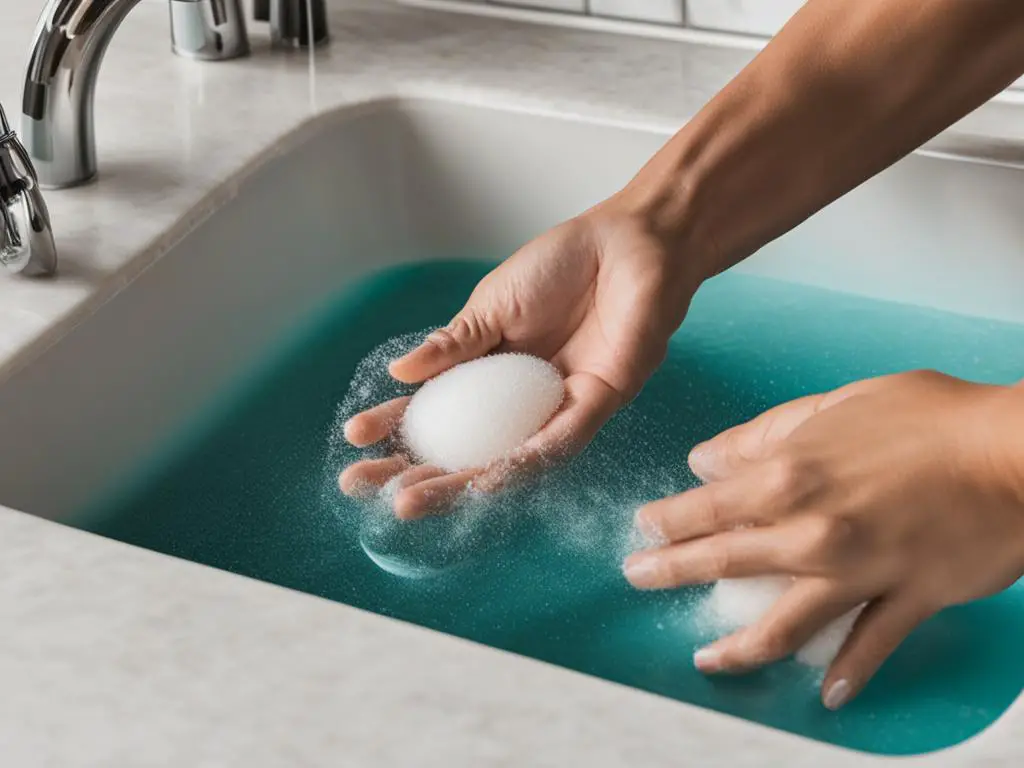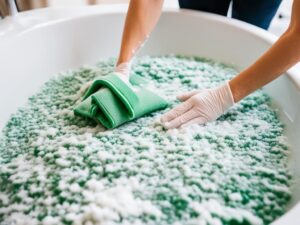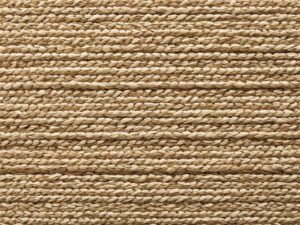Non-slip rug pads are a valuable addition to any area rug, providing stability and preventing accidents caused by slippage. Over time, these pads can accumulate dirt, spills, and debris, which may affect their performance. Fortunately, washing non-slip rug pads is a simple task that can help keep them fresh and functional for years to come.
Before diving into the washing instructions for non-slip rug pads, it’s essential to understand that these pads are designed to last a lifetime with minimal maintenance. They are free from glues, chemicals, or adhesives, making them resistant to mold or mildew when exposed to liquid. This means you can wash them with confidence without worrying about any negative impacts.
To ensure that your non-slip rug pads remain in optimal condition, follow these cleaning tips:
Key Takeaways:
- Non-slip rug pads can be washed safely to maintain their functionality and longevity.
- These pads are free from glues, chemicals, or adhesives, making them resistant to mold or mildew.
- Follow the appropriate cleaning methods to remove dirt, spills, and debris from the rug pads.
- Regular maintenance, such as vacuuming and shaking out the pads, helps keep them clean and fresh.
- Proper care and maintenance of non-slip rug pads prolongs the lifespan of both the pad and your area rug.
Tips for Cleaning Non Slip Rug Pads
Properly cleaning and maintaining your non-slip rug pads is essential to ensure their longevity and effectiveness in keeping your rugs in place. By following these tips, you can keep your rug pads clean and maintain their grip for a safer and more comfortable living space.
1. Clean up spills promptly:
Accidents happen, and when spills occur on your rug pads, it’s important to address them promptly. For felt pads, blot the spills gently and spot treat as needed using mild, dye-free detergent or dish soap. Rubber memory foam pads, on the other hand, can be easily wiped clean with a paper towel.
2. Vacuum solid material pads:
To remove dirt, dust, and debris that accumulate over time, vacuum your solid material rug pads, such as those made of felt or memory foam. Depending on the foot traffic in your home, vacuuming every 1-2 years should be sufficient. However, open-weave rubber pads do not require direct vacuuming; instead, ensure the floor beneath them is cleaned at least once a year.
3. Shake out rug pads periodically:
To maintain the cleanliness of your rug pads and rid them of dust and debris, periodically take them outdoors and give them a good shake. This simple act helps restore their freshness and grip, ensuring the longevity of both your rug pads and your rugs.
Remember to always refer to the manufacturer’s instructions for specific cleaning recommendations tailored to your non-slip rug pads. By incorporating these cleaning tips into your routine, you can effectively care for your rug pads and enjoy the benefits they provide for years to come.
Recommended Cleaning Frequency for Non-Slip Rug Pads:
| Type of Rug Pad | Cleaning Frequency |
|---|---|
| Felt | Spot clean spills; vacuum every 1-2 years |
| Rubber Memory Foam | Wipe clean spills; vacuum the floor beneath once a year |
| Open-Weave Rubber | Vacuum the floor beneath once a year; shake out periodically |
Keep in mind that these cleaning frequency recommendations are general guidelines. Depending on your specific circumstances, such as the level of foot traffic in your home, you may need to adjust the frequency accordingly for optimal maintenance.
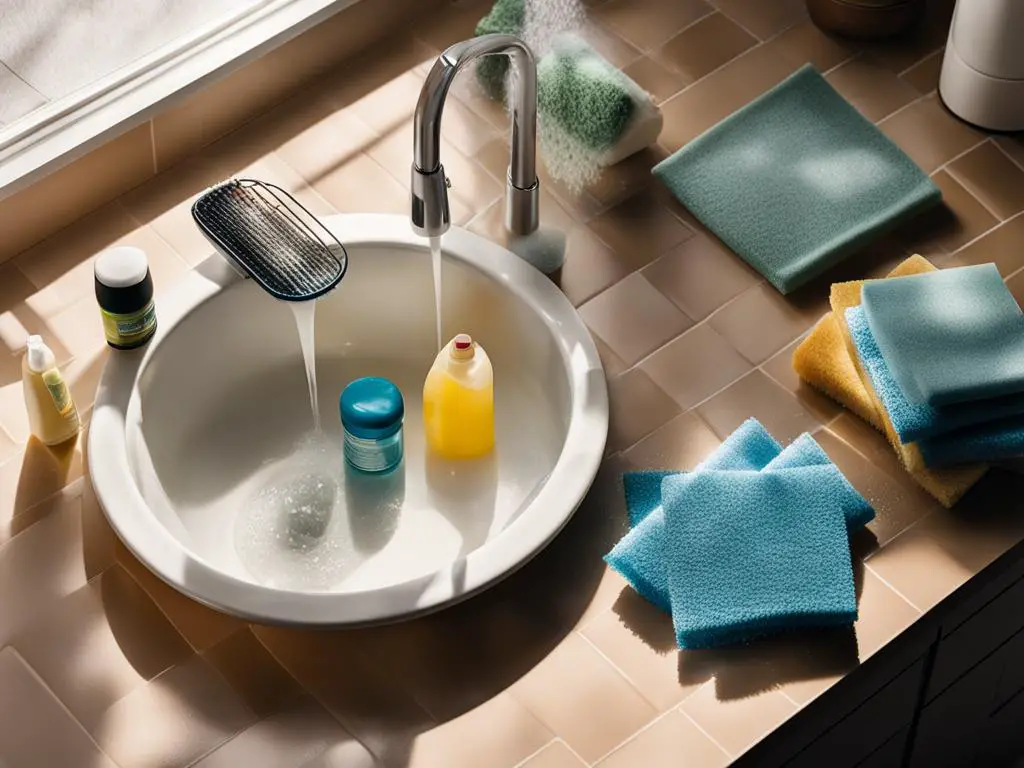
How Often to Clean Rug Pads
Rug pads play an essential role in preserving the life and functionality of your area rugs. While regular cleaning is essential to maintain the cleanliness and longevity of both rugs and rug pads, the frequency of cleaning can differ.
Unlike area rugs, rug pads do not accumulate as much dirt or debris, and thus do not require as frequent vacuuming. Generally, a quarterly vacuuming schedule is sufficient to keep your rug pads clean and fresh.
However, the cleaning frequency may vary depending on whether you have indoor or outdoor rug pads. Outdoor rug pads, which are exposed to the elements and foot traffic, should be thoroughly vacuumed before storage and at least twice a month during active seasons.
Indoor area rugs typically require less frequent maintenance. Monthly shakeouts are enough to remove any dust or loose particles. For households with multiple pets or higher foot traffic, more frequent shaking is recommended to ensure optimal cleanliness.
Summary: Cleaning Schedule for Rug Pads
Here’s a summary of the recommended cleaning schedule for rug pads:
| Type of Rug Pad | Cleaning Frequency |
|---|---|
| Outdoor Rug Pads | Thorough vacuuming before storage and at least twice a month during active seasons |
| Indoor Area Rugs | Monthly shakeouts; more frequent for households with multiple pets or higher foot traffic |
By adhering to a regular cleaning schedule, you can ensure that your rug pads remain clean, odor-free, and maintain their grip and protective qualities for long-lasting use.
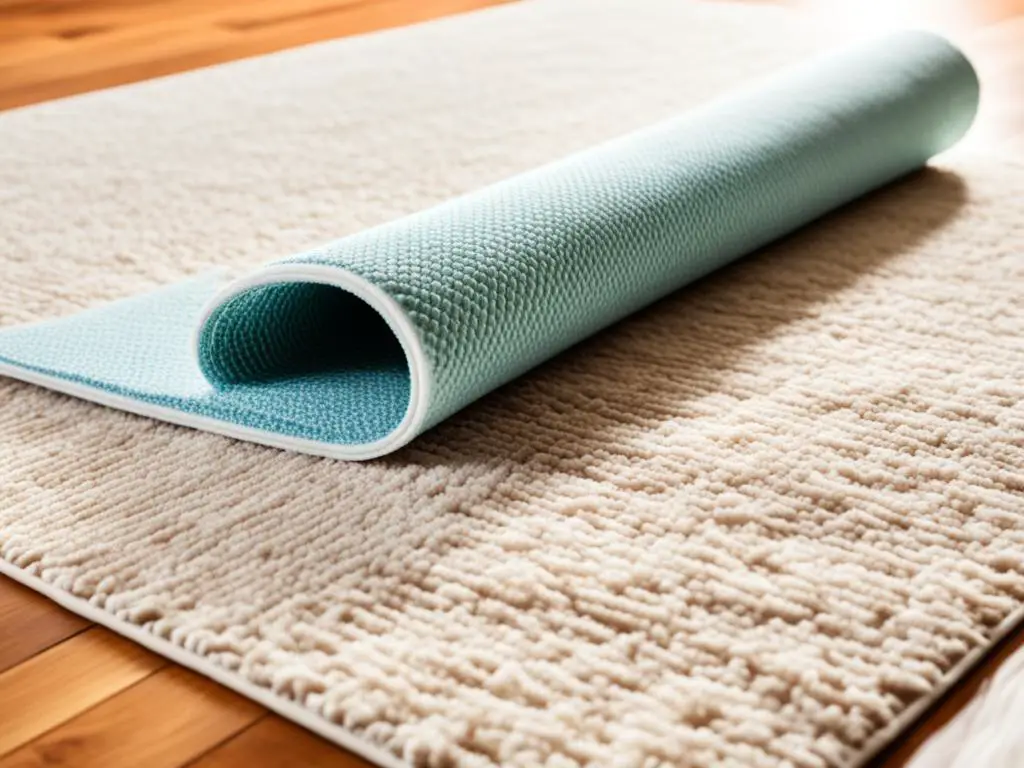
Addressing Spills on Rug Pads
Spills on rug pads can happen unexpectedly, but addressing them quickly is crucial to prevent staining and odor. Just like cleaning spills on rugs, cleaning spills on non-slip rug pads requires prompt action and the right approach to ensure the best results.
First, check to see if the spill has reached the rug pad. If it has, you’ll need to clean it the same way you would clean the rug itself. Blotting the spill with plain water is usually sufficient for most spills on rug pads. Use a clean cloth or paper towel to gently blot the spill, starting from the outer edges and working your way to the center. Avoid rubbing the spill, as this can cause the substance to sink deeper into the pad.
For deeper stains on the rug pad, you may need to use a mild, dye-free detergent or dish soap. Dilute the detergent with water and apply it to the stained area using a clean cloth or sponge. Gently blot the stain, being careful not to saturate the pad. Rinse the area thoroughly with plain water to remove any soap residue.
To summarize, here’s how to handle spills on rug pads:
- Act quickly to address the spill.
- Blot the spill with plain water, starting from the edges.
- For deeper stains, use a mild, dye-free detergent or dish soap.
- Gently blot the stain and rinse with clean water.
By following these simple steps, you can effectively treat spills on rug grips and keep your rug pads in clean and pristine condition.
In the next section, we will explore the benefits of using rug pads and how they can enhance your overall rug experience.
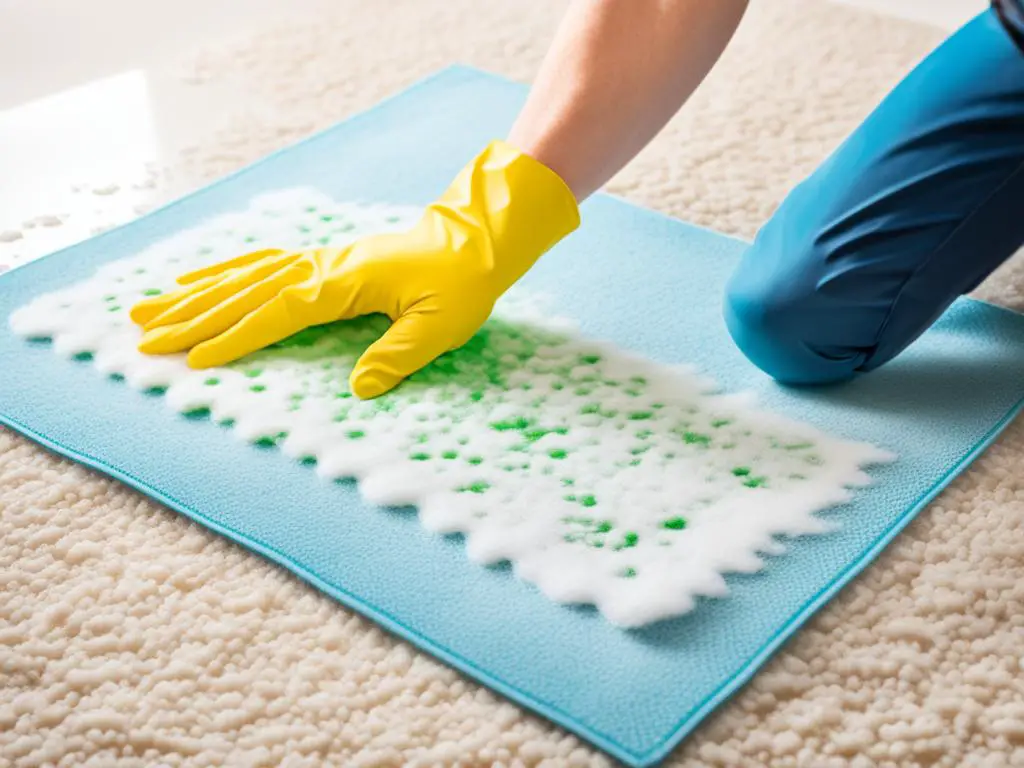
Benefits of Using Rug Pads
Rug pads offer a multitude of advantages that make them an essential accessory for any area rug. Here are some key perks of using non-slip rug pads:
- Extra Cushioning for Comfort: Rug pads provide an additional layer of padding between your rug and the floor, offering enhanced comfort underfoot. This extra cushioning is especially beneficial in high-traffic areas or rooms where you spend a lot of time standing.
- Noise Reduction: Non-slip rug pads help to dampen noise by absorbing the impact of footsteps and reducing the transmission of sound. This is particularly advantageous in apartments or multi-story buildings where noise can be an issue.
- Increased Safety: One of the primary advantages of rug pads is their ability to prevent rugs from skidding or sliding on hard surfaces. By providing traction and stability, rug pads help to minimize the risk of slips, trips, and falls, making your home safer for everyone.
- Efficient Vacuuming: Rug pads create a barrier between the rug and the floor, allowing air to circulate. This improves the efficiency of vacuuming, as the suction can penetrate through the rug more effectively, picking up dirt, dust, and debris.
- Prolonged Rug Life: Non-slip rug pads play a crucial role in preserving the quality and longevity of your area rugs. By preventing excessive wear and tear caused by friction and movement, rug pads help to extend the lifespan of both indoor and outdoor rugs.
Investing in a high-quality rug pad can significantly enhance your rug’s performance and ensure a more enjoyable and durable flooring experience. The benefits of using rug pads extend beyond aesthetics, providing comfort, safety, and protection for your rugs and your home.
Cleaning Process for Rug Pads:
If you want to learn how to clean your rug pads effectively, read on to Section 6.
Cleaning Process for Rug Pads
To ensure your rug pads stay clean and fresh, it’s important to follow a proper cleaning process. Here is a step-by-step guide on how to clean a rug pad:
- Roll up the rug to fully expose the pad. Take it to an area where it can get wet, such as a garage or driveway.
- Mix mild, dye-free detergent or dish soap with warm water in a bucket.
- Using a sponge, rub the cleaning solution across the entire surface of the rug pad. For deeper stains, use a soft bristle brush.
- Rinse away the cleaning solution with clean water. You can use a garden hose or buckets for this step.
- After rinsing, hang the rug pad on an elevated surface, such as a clothesline or railing, to allow it to dry completely.
- If you have a felt rug pad and want to neutralize odors, sprinkle baking soda on the surface before vacuuming.
Following these steps will help maintain the cleanliness and functionality of your rug pads.
| Cleaning Solution | Properties |
|---|---|
| Mild, dye-free detergent | Gentle on rug pads, does not contain harsh chemicals |
| Dish soap | Gentle and effective for removing dirt and stains |
| Warm water | Ideal for diluting the cleaning solution and rinsing the rug pad |
| Baking soda (for felt pads) | Neutralizes odors and refreshes the rug pad |
By following these cleaning steps and using the appropriate cleaning solutions, you can keep your rug pads in excellent condition and prolong their lifespan.
Maintenance Tips for Rug Pads
In addition to regular cleaning, properly maintaining your rug pads is essential for their longevity and effectiveness. Here are some maintenance tips to keep your rug pads in good condition:
- Avoid placing heavy furniture directly on the rug pad to prevent premature wear and tear. Instead, use furniture pads or glides to distribute the weight evenly.
- Regularly rotate your rug to even out the wear on the pad. This helps prevent uneven compression and extends the lifespan of both the rug and the pad.
- Avoid excessive moisture or humidity exposure, as this can affect the performance of the rug pad. If you live in a humid climate, consider using a dehumidifier in the room to regulate the moisture levels.
- If your rug pad becomes damaged or worn out, it’s important to replace it. A worn-out pad may lose its non-slip grip, compromising the safety and stability of your rug.
By following these maintenance tips, you can ensure that your rug pads stay in optimal condition, providing the necessary support, cushioning, and grip for your area rugs.
Conclusion
In conclusion, washing non-slip rug pads is a safe and effective way to maintain their freshness and functionality. By implementing proper cleaning and maintenance techniques, you can extend the lifespan of your rug pad and benefit from the added support and grip it provides.
Regular vacuuming of the rug pads, along with prompt cleanup of any spills, is crucial for keeping them in optimal condition. Additionally, periodically shaking out the pads helps remove dust and debris, ensuring their effectiveness in preventing rugs from skidding.
Remember to check the rug pad if spills have reached it and clean it accordingly. Avoid using harsh chemicals or abrasive cleaners, as they can damage the pad’s surface. With a little tender loving care, your non-slip rug pads will continue to provide the stability and safety your area rugs need.
